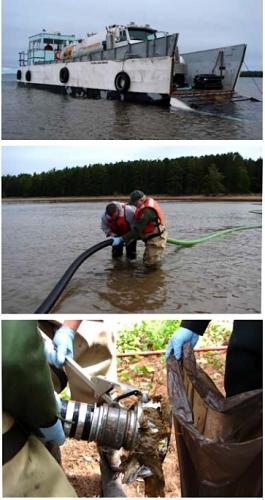Campers might not be too happy come mid-summer or so at Apostle Islands National Lakeshore, where budget cuts could leave vault toilets at some island campsites full.
As lakeshore officials sorted through their budget for spots where they could cut 5 percent per the federal budget sequestration, one of the areas that was identified was their contracting budget. Some of that money is spent on hiring a landing craft on a per-hour basis that can ferry a sewage disposal truck (aka honey dipper) to the islands to remove the contents of vault toilets used by backcountry campers.
Apostle Islands has had to contract for landing craft (LCM) services since 2011, when their 1953 Korean War surplus vessel finally reached the end of its usable life, according to Superintendent Bob Krumenaker. Neither the park nor the regional office has been able to afford to replace the LCM, which is critical to operating this water-based park, since even a more efficient, scaled-down replacement costs in the neighborhood of $600,000.
"The $15,000 reduction of funds available for rental of a landing craft vessel reduces the availability of the LCM by half, from 16 days to 8 days of use for the entire summer season," park officials said. "This reduction would delay pumping vault toilets, necessitating the closure of 6 restrooms for park visitors on 4 islands. Approximately 500 visitors would be affected."
Additionally, cutbacks in Apostle Island's fuel budget also could lead to a suspension of island patrols by rangers who use motorboats to reach the park’s 21 islands, of natural resource monitoring of endangered species (piping plovers), of routine maintenance, and interpretive programs.
A loss of overtime authorization could lead to trouble for visitors who are injured or lost in the lakeshore after regular hours, and reduce efforts to prevent human interactions with black bears.
Park officials have compiled the following list of backcountry toilet sites that they will pump on a "first full, first pumped" basis until they run out of money: Rocky Island Dock, Oak Island sandspit (group site), Oak Island site 4, South Twin Island, Stockton Island – Julian Bay, Stockton Island – Presque Isle site 12, Sand Island East Bay group site B, and Devils Island light station.
Of those, Devils Light, Oak Island sandpit group site, and the Oak Island site 4 have no nearby alternatives, so if their vault toilets get full, those areas might have to be closed, according to lakeshore officials.
Superintendent Krumenaker emphasized that it’s difficult to predict at the beginning of the year which island toilets will need pumping, as it varies with visitor patterns, which in turn vary tremendously with both weather and the economy.
“We don’t think we’ll have to face this until the end of summer, and will be as strategic as we can be deploying the LCM so we pump as many sites as cost-effectively as we can," the superintendent said. "For obvious reasons, we’ll try hard not to adversely affect the more popular sites. But those are also the ones that need pumping more frequently, of course, and cost more to maintain.
"Unfortunately, however, there’s so little flexibility in our budget now that some things will have to be cut back.”




Comments
Let's see: first EC says "time to quit wasting money on monitoring plovers and interpretive programs."
Then in response to this paraphrase of his comment, "Wildlife and interpretive programs [i.e., public education] are a waste," he says: "That is your comment not mine."
EC, if you're not already in politics, you'd fit right in with the current crop of spinmeisters :-)
The irony of this interchange given the subject of the original story is priceless.
Mtnliving.
You are indeed correct, I did use those words. I had only looked back to the prior post to which I thought Rick was responding and had forgotten about the earlier post. Perhaps waste was too strong a word but I certainly will stand by my prioritization.
Nice response, EC. I'd agree the issue is one of priorities, not waste.
But interpretive programs are one of the most valuable things NPS does in our parks. Most people enjoy and really need interpreters to help them understand the dynamics of parks. An interpretive ranger is a flashlight in the dark for most visitors.
I really do hope, though, that we never ever see pay potties. Can you imagine trying to find that darned quarter in a pouring rain on a dark night illuminated only by bolts of lightning?
Lee - You're absolutely correct on both counts :-)